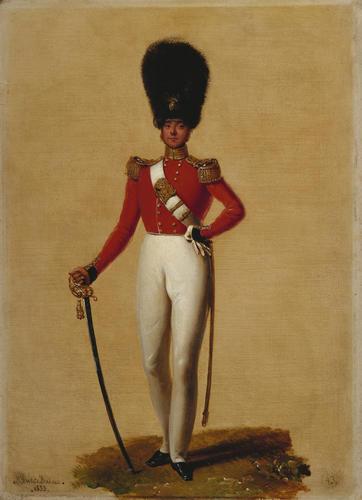-
1 of 253523 objects
Officer, 7th Regiment of Foot (or Royal Fusiliers) Signed and dated 1833
Oil on card | 34.9 x 25.4 x 0.2 cm (support, canvas/panel/stretcher external) | RCIN 407110

Alexandre-Jean Dubois Drahonet (1791-1834)
Officer, 7th Regiment of Foot (or Royal Fusiliers) Signed and dated 1833
-
In 1832 French portraitist Alexandre-Jean Dubois Drahonet was commissioned by William IV to paint one hundred pictures illustrating the uniform of the British Army. The Royal Collection retains most of this series. A photograph of the Equerry’s Room at Windsor Castle taken in around 1900 shows some of these paintings hanging together, framed in groups.
During the period of peace following the Napoleonic Wars, increasingly elaborate (and often quite impractical) military attire was devised, particularly by George IV. By the time William IV came to the throne in 1830, uniforms had become too expensive and were simplified and adapted once again. The result of these changes was codified and promulgated in the 1831 Dress Regulations. These paintings were intended to provide a visual record of the recent changes to military dress. Their value is not only historical, however, but also aesthetic: Drahonet produces lively, slightly elongated figures, capturing their facial expressions and setting them in a variety of organic poses.
Each painting in the series depicts a single figure against a neutral background. This is one of the few in the series without an inscription identifying the sitter’s name, regiment and rank, although the figure’s uniform indicates that he is an Officer of the 7th Regiment of Foot (or Royal Fusiliers). The Fusiliers were so called because they carried light flintlock fusils, rather than the heavier muskets used by the rest of the Infantry.
As an Officer, this figure does not carry a fusil here but instead poses with an elaborate basket-hilt sword. He wears the conventional uniform of the regiment (see 407047), although with the double-breasted coatee and gold bullion epaulettes reserved for his rank. The flaming grenade badge on his bearskin and the design of his belt plate (a Rococo pattern introduced to the regiment in around 1830, depicting a rose, crown and banner) provide further evidence that the figure was part of the Royal Fusiliers.
Provenance
Commissioned by William IV
-
Creator(s)
-
Medium and techniques
Oil on card
Measurements
34.9 x 25.4 x 0.2 cm (support, canvas/panel/stretcher external)
49.5 x 40.0 x 3.0 cm (frame, external)
Other number(s)
HMD add-DrahonetJSS 69A